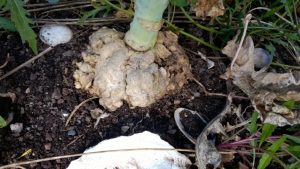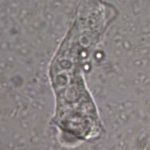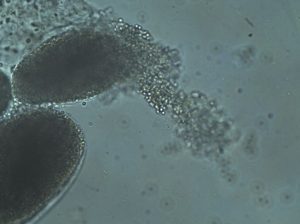Your Hori-Hori Could be Harboring Clubroot
November 26, 2019
© 2020
I meet weekly with the DirtLife group at Sound Bio Lab. Other members are scientists who are  also interested in soil. We are designing a community-based science project so we surveyed the Seattle P-Patch gardeners, via their listserve. Fifty responded. Gardeners are interested in microbial diversity, effective composting and concerned about soil-borne fungal pathogens, especially clubroot.
also interested in soil. We are designing a community-based science project so we surveyed the Seattle P-Patch gardeners, via their listserve. Fifty responded. Gardeners are interested in microbial diversity, effective composting and concerned about soil-borne fungal pathogens, especially clubroot.
A few months ago we began reading peer-reviewed research articles on these topics. We will develop a project that will:
Make use of the lab resources available at SoundBio
Provide a tangible benefit to Seattle urban farmers
Integrate SoundBio and community volunteers in carrying out the project
In the meantime, after reading well over a dozen research articles, I thought I would share mentioned cultural practices that are important to minimize the impact of clubroot (Plasmodiophora Brassicae or P. Brassicae) and its spread. For details about this pathogen see the Club Root Summary doc on our Library page.
At FECO, we have adopted most of the preventative measures listed below.
Prevention of clubroot
Don’t plant brassicas within 7 years after an infection. P. Brassicae resting spores can live 20 years, but have a half-life of 4 years. See OSU Pub 9148 pdf in the Library Page. It lists crops and weed hosts.
Rotate brassica crops (only effective for soil and root pathogens like P. Brassicae that are biotrophic and have a narrow range of hosts).
Favorable conditions for the pathogen include warm, wet soils (optimal temperatures between 68ºF and 80ºF) and the infection period is most likely within six weeks after planting. June and July sowings, if clubroot is present, can increase incidence and severity of the disease.
Keep plants healthy; they have incredible defense mechanisms.
Develop disease-suppressive soils by introducing organic matter (OM). The benefits accumulate across successive years leading to improved soil health and structure.
Try clubroot-resistant cultivars but they may or may not work. Studies show that P. Brassicae can rapidly erode the resistance of a newly-developed resistant cultivar. In other words, it quickly morphs into a new pathotype that conquers the resistant cultivar.
You can try adding calcium carbonate (“liming”) to reduce the likelihood of resting spore germination. This is a very complex, and a bit controversial, issue. At soil pH higher than 6.5, iron and zinc are less available to plants.
A group of farmers from Alberta (where canola is grown) were surveyed and they did not follow appropriate protocols. In the Library is an OSU Pub 9057 that outlines how to incorporate lime – based on soil type, and also how to monitor pH before and after application. Soil pH lab tests, including the important pH buffer test, only cost $5.20 at Northwest Agricultural Consultants.
Sun, Dec 15, 2-4, Work Party
Sat, Jan 4, 10-12, Work Party
Sun, Jan 19, 2-4, Work Party
Cultural Practices
Infected transplants are the most prevalent source for the spread of pathogens into an uninfected area. Flats of transplants from greenhouses should not be placed on the soil to harden off. Reused trays are reported to be a high risk for pathogen contamination.
Knock off soil from all tools, boots, gloves at the location where you were working the soil.
Brush off and/or wash any remaining mud or clinging soil.
If you know the disease is present, disinfect tools etc with a 2% concentration of sodium hypochlorite bleach (mix an amount of regular 6% household bleach with twice that amount of water). Note: You can’t disinfect a tool with soil on it. Soil cannot be disinfected this way.
Consider pavers or tiles in beds when it’s necessary to step into the garden bed.
Avoid excess watering and ensure good drainage.
Use mulches to physically isolate above ground plant parts from contact with the soil.
Plant cover crops. When incorporated into the soil, residues from some cover crops release chemicals that either directly inhibit pathogens or enhance soil microbe populations that can compete with pathogens.
Infected plant disposal
Dig those infected plants out! Digging is better than pulling, to get most or all of the root system. Use a sack so spores can be contained.
I must have read 11 articles that said, “Dispose of infected soil and plants properly.” Isn’t that helpful. I had to hunt for this information:
Infected plants can be thermally composted with temperatures of 122ºF for 7 days or 140ºF for one day, if the pile is maintained at 50% moisture (squeeze a handful of compost and drops of water should exude).
You can put the plants in your yard waste because it goes to a facility that uses thermal composting. However, be aware of the risk of leakage from your plot to the compost facility.
Infected plants can be put into your pressure cooker with water, then cooked on high for 30 minutes. After this has cooled, open the lid, stir, then repeat the cooking. That’ll get ’em.
Soil, shaken from the roots of infected plants, plus soil from brushing/washing off tools, can be buried 12 inches. The hole should not be where flooding will occur and it should remain undisturbed. (You will have to dig a new hole next year.)
Research indicates that good cultural practices can serve well to fight this and other soil-borne pathogens, and these practices are well within our control.
If you have a history of success with other sanitation/cultural practices, please share them via the comments section.
Ruth
Koike, S, 2003, Vegetable Diseases Caused by Soil-borne Pathogens, Pub 8099
Gossen, B.D., 2012, Effects of temperature on infection and subsequent
development of clubroot under controlled conditions
https://bsppjournals.onlinelibrary.wiley.com/doi/full/10.1111/j.1365-3059.2011.02536.x
LeBoldus J.M., 2012, Adaptation to Brassica Host Genotypes by a Single-Spore Isolate and Population of Plasmodiophora brassicae (clubroot)
https://apsjournals.apsnet.org › doi › pdf › PDIS-09-11-0807
Burnett, F., 2013, Management of clubroot (Plasmodiophora brassicae) in winter oilseed rape
Buriel methods – disposal practices – plants and animals
Texas A&M Agrilife Extension
Click to access burial-methods-disposal-practices-plants-animals-1.pdf
Preventing Clubroot – Agricultural Sanitization
2019, Government of Alberta
https://open.alberta.ca/publications/preventing-clubroot-agricultural-sanitization-which-disinfectants-kill-resting-spores
L. Fayolle, 2006, Eradication of Plasmodiophora brassicae during composting of wastes
https://bsppjournals.onlinelibrary.wiley.com/doi/full/10.1111/j.1365-3059.2006.01399.x

Very informative and interesting!